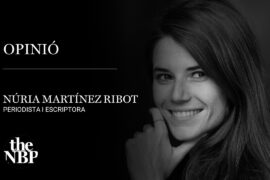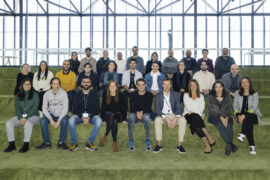
Take a deep breath. Alright? We are going to talk...

Find out which are the 26 restaurants with Michelin Star...

In a few years on the market, Tesla has established...

There are things that only happen once in a lifetime....

Just as in the universe there are so many planets...

From the Sociedad Catalana para el Alumbrado por Gas, founded...

Why have the Real Estate Market Listed Public Limited Companies—the...

Who is primarily responsible for the so-called "greenhouse effect"? What...

When Rupert and Kristin Isaacson saw Rowan, their son with...

CosmoCaixa commemorates the half century of the arrival to the...

Música clásica sobre la arena de la playa en dos...

The first session of the cycle on the regatta organized...

The hospital's managing director, Manel del Castillo, and the pharmaceutical...

Generalitat y Ayuntamiento impulsarán dos equipamientos de 'Casa de les...

Leticia Beleta, director of Alexion Pharmaceuticals in Spain and Portugal,...

We all have a friend who never leaves the Gràcia...

Barcelona director opts for Best International Film with 'La sociedad...

The hotel and industrial sectors softened the market's decline last...

The technology company, with a workforce of 35 employees and...

“The women of yesteryear were strong and had to fight...

It is quite rightly claimed that reading has always been possible because of the sense of view, with hardly no substantial modifications as regards the way of relating readers with the texts. However, one of the clearest and most relevant episodes of the evolution of intellectual habits is quoted by Saint Augustine. He witnessed, with astonishment, Saint Ambrose reading silently, enjoying the words and hardly moving his lips. Anachronism stalks the belief that reading has always been a silent practice, and such belief would consider reading as an activity of self-absorption whereby, somehow, the world disappears, and the reader belongs to the reading activity, to which he succumbs. Nowadays, everyone knows that texts are read on a screen, in a tactile reading, can be touched and moved around, welcome readers to turn over the page with a simple gesture or can be commentated upon by one or more readers.
Many pictures by Pablo Picasso are called The Reading which, by the 20th century, transfer a participation of sorts in the reading activity, likened, in turn, to that narrated in Julio Cortázar’s Continuidad de los parques: it produces and reproduces the disappearance of the subject-reader, divided and dislodged, an actor passively moved by the other, who is himself. Deep inside, the novel that opens up this enthralling ambiguity is The Quixote; a novel read and commentated upon by its protagonists, a reversal that precipitates the reader into the sweet hollow of fiction. Certainly, this novel —this novel’s reality— exists virtually, maybe for the first time, beyond the weird and lost physical support, and three temporal issues: it exists for what is said in the present of the narrative, for what it alludes to from the past, implicitly —i.e. cavalry novels—, and the expectation of uncountable re-readings it fosters. El Quijote de Pierre Ménard, a story by Jorge Luis Borges, summarizes ad absurdum the novel perplexity of the hermeneutic world that, half-consciously, Miguel de Cervantes opened up: now there is no written text that does not write about another text, or at least is linked to it, and the link becomes the reader that “is read” by both.
On screen, the words can be almost seen as pictograms or icons, have their own value and can be moved around or manipulated. Certainly, the visual immediacy that enables digitalization carries an implicit risk of an excessively automatized reading by a reader who would retain little or hardly nothing.
Viewing content on tablets and computers updates the idea of a mnemonic palimpsest, a textual support re-used for writing a new text. This unveils the virtuality of knowledge, the artificial nature of things written, in that it sets up a network —a library— and a specific way of moving around in search for contents. On screen, the words can be almost seen as pictograms or icons, have their own value and can be moved around or manipulated. Certainly, the visual immediacy that enables digitalization carries an implicit risk of an excessively automatized reading by a reader who would retain little or hardly nothing. But it also opens up the possibility of practising commentaries, the personal mark-up or hyperlinks: these landmarks in the virtual text that make the reading, make it possible to get an interpretation from someone who sees himself as participant of the (in)existent. At the beginning of philosophical writing, Plato had sensed the dangers of fixing contents which, in the author’s absence, could be understood differently, even contrary to those of the author’s original intentions. The internet era has hyperbolized this problem, and has teamed up with the post-modern death of the author, turned into premise for a type of interpretation suspicious of authoritarian arguments.
So now, where does reading go? Is there a middle way between re-writing —i.e. interpretation and summary of paragraphs, a more intellectual practice— and the mere visualization of contents, regarded as virtually truthful? Too frequently does virtual information acquisition and accumulation presuppose its actual comprehension, as if the effort of interpretation were not necessary. Does the digitalization of The Karamazov Brothers,
its comprehension in a simple computer file, guarantees its comprehension, apart from verifying the popular proverb that “knowledge does not take up any space”? Knowledge may not take space, which is an advantage, but it does not necessarily alleviate or facilitate the understanding of contents that can hardly be assimilated on the way home or to work, and separates many users of mobile phones. Reading a nineteenth-century novel at intervals of ten minutes, fifteen minutes, means spending months with a virtual novel; if the possibility of reading is longer, and takes place in a cozy couch, then the weight and the smell of history of a paper book will not be such an issue.
However, for young generations – immersed in digital reality from birth— it is unlikely that they will feel any type of nostalgia whatsoever, or that behave with books just like someone who collects vinyl: items of worship, unpractical, evokers of an era where physical support, apparently beautiful, made something real. Something deceitful, as there is no more reality in the material than in the virtual. Further clichés demolished? It is false that digital reading is easier and more accessible. Certainly, it enables wider dissemination, but the reading activity will continue to be a pleasure and a burden, a liberation and an obligation, dissemination of ideas and entrenchment of dogmas, opening to life or consolidation of idiocy, and nobody can offer a firm guarantee on which side we stand.

It is quite rightly claimed that reading has always been possible because of the sense of view, with hardly no substantial modifications as regards the way of relating readers with the texts. However, one of the clearest and most relevant episodes of the evolution of intellectual habits is quoted by Saint Augustine. He witnessed, with astonishment, Saint Ambrose reading silently, enjoying the words and hardly moving his lips. Anachronism stalks the belief that reading has always been a silent practice, and such belief would consider reading as an activity of self-absorption whereby, somehow, the world disappears, and the reader belongs to the reading activity, to which he succumbs. Nowadays, everyone knows that texts are read on a screen, in a tactile reading, can be touched and moved around, welcome readers to turn over the page with a simple gesture or can be commentated upon by one or more readers.
Many pictures by Pablo Picasso are called The Reading which, by the 20th century, transfer a participation of sorts in the reading activity, likened, in turn, to that narrated in Julio Cortázar’s Continuidad de los parques: it produces and reproduces the disappearance of the subject-reader, divided and dislodged, an actor passively moved by the other, who is himself. Deep inside, the novel that opens up this enthralling ambiguity is The Quixote; a novel read and commentated upon by its protagonists, a reversal that precipitates the reader into the sweet hollow of fiction. Certainly, this novel —this novel’s reality— exists virtually, maybe for the first time, beyond the weird and lost physical support, and three temporal issues: it exists for what is said in the present of the narrative, for what it alludes to from the past, implicitly —i.e. cavalry novels—, and the expectation of uncountable re-readings it fosters. El Quijote de Pierre Ménard, a story by Jorge Luis Borges, summarizes ad absurdum the novel perplexity of the hermeneutic world that, half-consciously, Miguel de Cervantes opened up: now there is no written text that does not write about another text, or at least is linked to it, and the link becomes the reader that “is read” by both.
On screen, the words can be almost seen as pictograms or icons, have their own value and can be moved around or manipulated. Certainly, the visual immediacy that enables digitalization carries an implicit risk of an excessively automatized reading by a reader who would retain little or hardly nothing.
Viewing content on tablets and computers updates the idea of a mnemonic palimpsest, a textual support re-used for writing a new text. This unveils the virtuality of knowledge, the artificial nature of things written, in that it sets up a network —a library— and a specific way of moving around in search for contents. On screen, the words can be almost seen as pictograms or icons, have their own value and can be moved around or manipulated. Certainly, the visual immediacy that enables digitalization carries an implicit risk of an excessively automatized reading by a reader who would retain little or hardly nothing. But it also opens up the possibility of practising commentaries, the personal mark-up or hyperlinks: these landmarks in the virtual text that make the reading, make it possible to get an interpretation from someone who sees himself as participant of the (in)existent. At the beginning of philosophical writing, Plato had sensed the dangers of fixing contents which, in the author’s absence, could be understood differently, even contrary to those of the author’s original intentions. The internet era has hyperbolized this problem, and has teamed up with the post-modern death of the author, turned into premise for a type of interpretation suspicious of authoritarian arguments.
So now, where does reading go? Is there a middle way between re-writing —i.e. interpretation and summary of paragraphs, a more intellectual practice— and the mere visualization of contents, regarded as virtually truthful? Too frequently does virtual information acquisition and accumulation presuppose its actual comprehension, as if the effort of interpretation were not necessary. Does the digitalization of The Karamazov Brothers,
its comprehension in a simple computer file, guarantees its comprehension, apart from verifying the popular proverb that “knowledge does not take up any space”? Knowledge may not take space, which is an advantage, but it does not necessarily alleviate or facilitate the understanding of contents that can hardly be assimilated on the way home or to work, and separates many users of mobile phones. Reading a nineteenth-century novel at intervals of ten minutes, fifteen minutes, means spending months with a virtual novel; if the possibility of reading is longer, and takes place in a cozy couch, then the weight and the smell of history of a paper book will not be such an issue.
However, for young generations – immersed in digital reality from birth— it is unlikely that they will feel any type of nostalgia whatsoever, or that behave with books just like someone who collects vinyl: items of worship, unpractical, evokers of an era where physical support, apparently beautiful, made something real. Something deceitful, as there is no more reality in the material than in the virtual. Further clichés demolished? It is false that digital reading is easier and more accessible. Certainly, it enables wider dissemination, but the reading activity will continue to be a pleasure and a burden, a liberation and an obligation, dissemination of ideas and entrenchment of dogmas, opening to life or consolidation of idiocy, and nobody can offer a firm guarantee on which side we stand.
